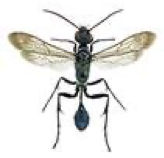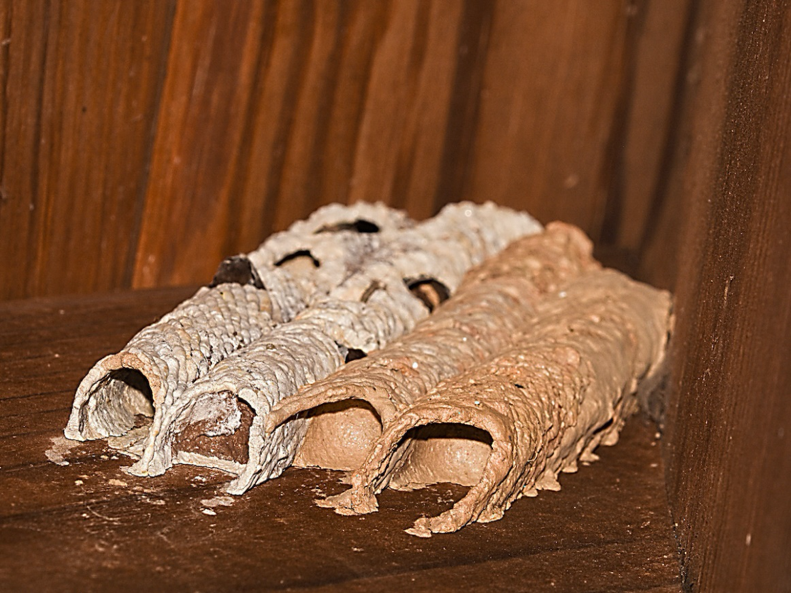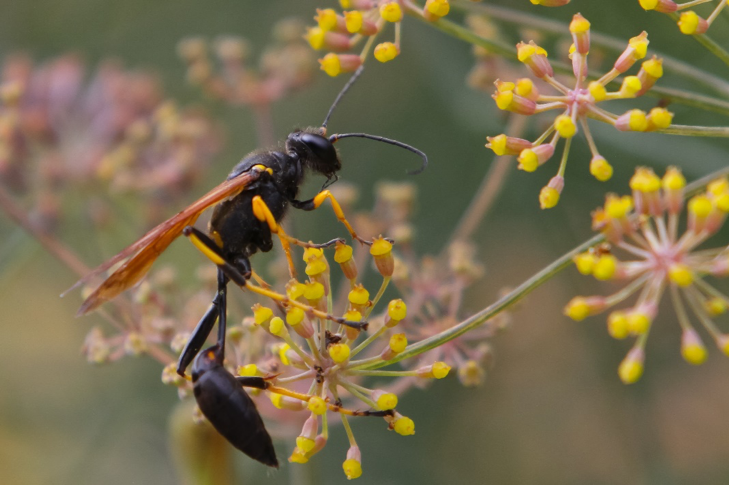
Mud wasps, also call “mud daubers”, are considered to be stinging insects even though they are fairly docile. Commonly found throughout California, mud wasps build nests on the side of homes and buildings every spring. Mud wasps are easily identifiable due to their long legs that hang below their dark blue or black and yellow bodies as they fly around. Unlike pests that live in large colonies like yellow jackets, mud wasps live alone with their young in a single nest. Spotting a single mud wasp or a nest on your home does not indicate a heavy infestation. Although mud wasps aren’t aggressive, the nests that they create are unsightly when created on the side of your house.
How can I tell if I have mud wasps?

If you suspect that mud wasps are infesting your home, the first thing to do is identify the nest. By ruling out other stinging insects, you can be sure that mud wasps are the pest you are dealing with. Mud wasps use mud or clay that is located in the area to build nests, where a single adult will live. Depending on the type of mud wasp that’s living on your property, nests could look like long tubes that are stacked side by side, or as if someone threw a pile of mud at the side of your house. The nests are large enough to host eggs and paralyzed spiders. In most cases, mud wasps will not select the same place to nest between generations. This means current mud wasp activity doesn’t necessarily guarantee nest building year after year.
Common nesting sites include under the eaves and soffits on the exterior of homes and buildings as well as under decks and porches. Covered areas that are off of the ground are ideal spots to find mud wasp nests. They construct nests on the surface of the chosen structure rather than hanging from vegetation. For that reason, you may not notice the nests because they are made in unobtrusive areas.
Should I be worried about mud wasps nesting on my home?
Mud wasps are generally non-aggressive, living alone with their offspring in the spring and summer. They are actually considered to be beneficial to the environment because they eat spiders, more specifically the harmful black widow spider. The stinging power of a mud wasp is solely used on their prey, not as a defense mechanism to protect a colony or queen like other stinging insects do. Because of this reason, wasps are non-aggressive and rarely sting unless touched or caught in clothing. If you see holes in their nest, this indicates that the wasp reached its mature stage, has left, and most likely will not come back.
The only danger that mud wasps cause is when they leave a nest intact. Empty mud wasp nests can be easily taken over by other unfriendly wasps if not taken down. The nests are also unsightly and difficult to reach if the nest up high against the side of your home.
What attracts mud wasps to my house?

Mud wasps survive where they can find a steady source of food. Most mud wasps feed almost exclusively on spiders. If there are small insects in your area, spiders will follow. Where spiders live, there is a potential for mud wasp activity. Once a mud wasp catches a spider, they will bring it back to their nest to feed their offspring. Only female mud wasps build nests and hunt for spiders. The males can be seen hovering around flowers, consuming nectar and looking for a mate. Larvae remain in the nest over the winter and hatch in the spring when the weather warms up.
For the most amount of protection, their nests are built flush against surfaces in areas such as the sides of homes and buildings, under overhangs, and under eaves. Sometimes you will see groupings of mud wasp nests in close proximity. Although the nests can appear in groups, a single female mud wasp will create each nest.
How can I get rid of mud wasps?
If you find a mud wasp nest on the side of your home, garage, or shed, don’t panic. Mud wasps mostly avoid humans so they aren’t a big threat to homeowners. If you seeing holes on the nest, this is a sign of an abandoned or old nest. Mud wasps create holes to exit once they leave the nest with in intention of returning. The best way to prevent mud wasps is to prevent spiders. Spiders are the main diet for mud wasps so if you remove their food source, they will be less likely to nest. Seal the cracks and crevices around you home and take down visible spider webs on the exterior of your home to avoid spider activity.
DIY mud wasp nest removal is not advised. Without the proper training, tools, and knowledge of mud wasp biology, you run the risk of getting hurt or making the problem worse. Give us a call or fill out the contact form on this page to get started!
What Are Mud Wasps? Professional Pest Control Services in Tracy CA
Serving



